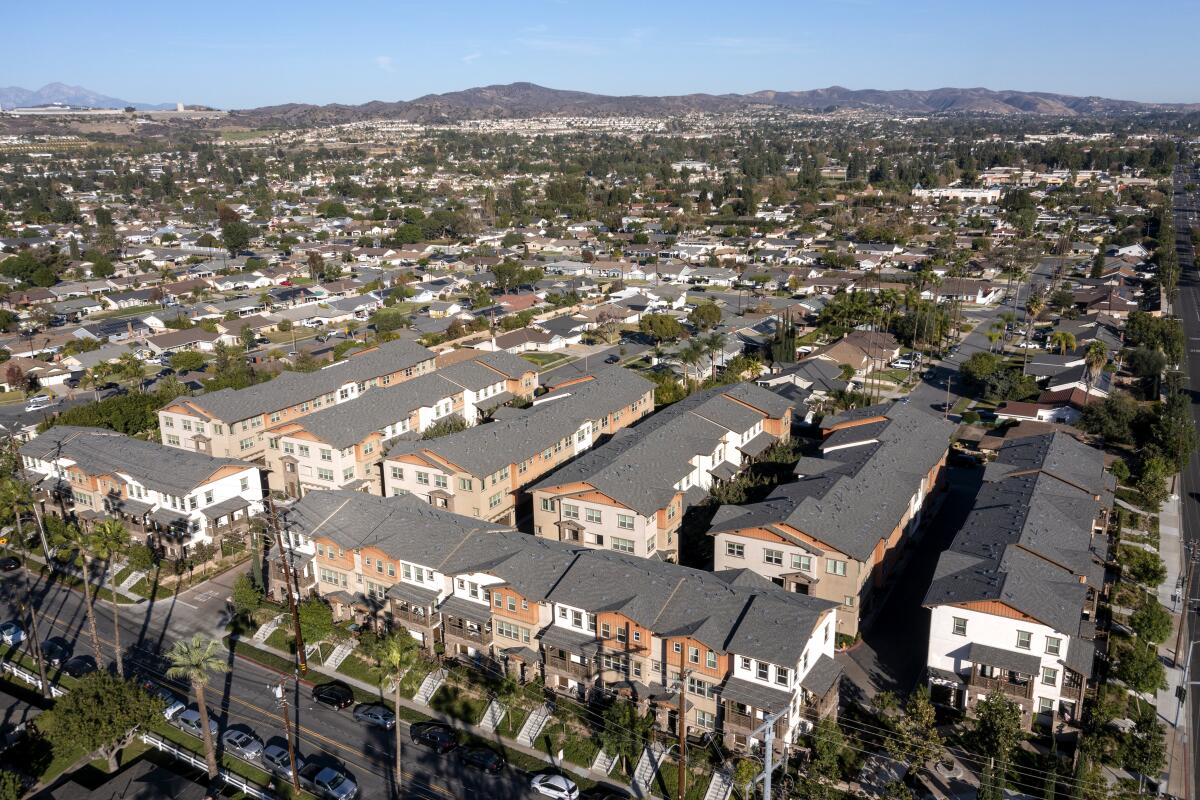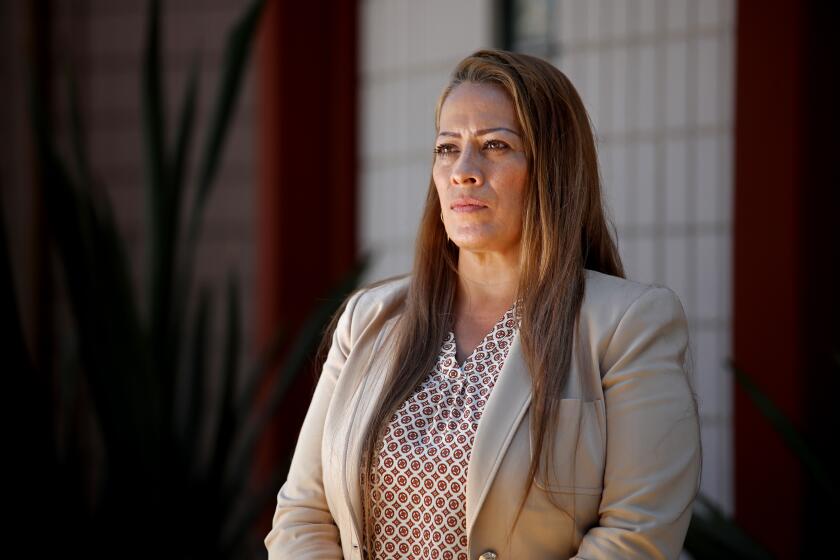Some sanity is finally returning to SoCal’s brutal apartment market: A rental guide

- Share via
Apartment hunting in Southern California is notoriously difficult. In the last two years, the search turned particularly nightmarish.
In part for pandemic-related reasons, the number of units available to lease fell to historical lows. Rent soared.
Some apartments even had bidding wars — an unwelcome reality typically limited to the for-sale market.
But now, a little bit of sanity is returning.
If you’re looking for a new rental, don’t expect a deal, but you may find the search less maddening.
What exactly is happening?
Simply put, there are more apartments for people to move into. Across the region, vacancy rates are rising after falling to decades-long lows in 2022 and 2021.
In Los Angeles County early last year, only 3.7% of apartments were vacant and available, the lowest level since 2001, according to real estate data firm CoStar. Now that measure is up to 4.4%.
It was even worse in both the Inland Empire and Orange County, where the vacancy level fell to about 2% in 2021. In Riverside and San Bernardino counties, that set a record in a data set that goes back to 1982; in Orange County it was essentially equal to a record set in 1984.
Vacancy has now doubled in both areas, up to 5.4% in the Inland Empire and 4.1% in Orange County.
In Ventura and San Diego counties, vacancy similarly fell below 3% in 2021 and is now 3.8% in San Diego and 5.4% in Ventura.
Rob Warnock, a researcher with the rental website Apartment List, said vacancy fell so low because many people moved out of shared living situations with family or roommates in 2021 and 2022. They wanted a place of their own and essentially created a wave of new households that gobbled up available rentals.
A rebounding economy, stimulus payments and a desire to no longer be cooped up with others like early in the pandemic probably helped drive the surge, Warnock said.
Now, the switch is flipped.
As consumers worry about inflation and the direction of the overall economy, they’re forming fewer households as new apartments continue to open up.
“Unemployment still looks good, but there is that uncertainty,” said Ryan Patap, an analyst with CoStar. “That makes people more cautious in spending up, committing to a new lease, moving out of their parents’ house — all of those dynamics.”
Richard Green, director of the USC Lusk Center for Real Estate, said another factor may be at play.
“The mystery [was] people are leaving California — how come vacancies weren’t rising?” he said. “Maybe it’s starting to show up.”
If you’re like most people in Southern California, you live in a rental.
What does that mean for me?
To be clear, vacancies are still far lower here than many markets around the country, which economists attribute to the difficulty of building housing in California. But if you are out there searching for a place, you may have an easier time than this time last year.
Michael Lucarelli is chief executive of RentSpree, a Sherman Oaks-based company that provides application and rent collection services for 41,000 leasing agents, property management firms and individual landlords in California.
With the rise in vacancy, he said renters are less likely to have to make snap decisions on whether a place is right for them, and he hears less and less about bidding wars at his client’s properties.
“It’s creating a little bit more leverage on the side of the renter,” Lucarelli.
What about rent?
By most measures, rent is still rising, but not as fast as it was.
Rising vacancy levels have not only made it harder for landlords to charge more, but after years of sharp increases some tenants are tapped out.
According to data from real estate firm RealPage, average asking rent for a vacant L.A. County apartment during the first quarter of 2022 was up 17% from the same period a year earlier.
But by the first three months of this year, rent growth had slowed, with prices rising 6% from 2022 levels.
A similar slowdown was seen in the Inland Empire, as well as Orange, Ventura and San Diego counties.
Data from Apartment List and CoStar indicate a more favorable environment for renters.
According to CoStar, average rent is still positive in all Southern California counties, but rising less than RealPage data show.
According to Apartment List, the median rent for a vacant unit has turned slightly negative in the Inland Empire, Orange County and Ventura County, dropping by less than 2% in April from the previous year.
In L.A. County, median rent was up just 0.21%.
Warnock says he expects rent across L.A. County to also turn negative in coming months, but he doesn’t expect rent there and elsewhere in Southern California to see a sustained, or meaningful drop, because too few rentals are being built.
“A 1% annual rent decrease is not going to bring much comfort to someone who is out there searching,” he said, particularly when Apartment List data show rent in L.A. County is 11% higher than the start of the pandemic and 33% higher in the Inland Empire.
What if I can’t afford the housing that is listed for rent?
That’s not uncommon in expensive Southern California.
One option you have is Section 8, a federal program run by local authorities. If you meet the income qualifications and receive one of the coveted vouchers, you can find housing with a private landlord on the open market and you’ll pay roughly a third of your income toward rent with the government paying the rest.
However, there aren’t enough vouchers for everyone who could qualify.
Fast-food workers make up 11% of all homeless workers in California and 9% in Los Angeles County, according to a report released Tuesday by Economic Roundtable.
You can check with your local government to see whether it is accepting applications, but it may not be. The city of Los Angeles opened its wait list last fall for the first time in five years, but it is now closed.
Another option you have is to apply to apartments reserved specifically for people of lower incomes. This can be government-owned public housing or housing built by nonprofits.
At times, for-profit developers include a handful of low-income units in their new projects as a condition of the project’s approval.
You can find more information on how to apply for these various apartments and subsidies in the following guides from The Times.
- How to apply for Section 8 and public housing
- How to find and apply for other types of affordable units.
If I don’t want to move, will my rent to go up?
Potentially.
Landlords say their costs to manage and maintain buildings have risen along with overall inflation, meaning unless they cut back on those expenses, they’ll need to raise rent if they want to keep earning the same amount.
At the same time, rising vacancies can be a threat to a property owner’s bottom line, and many landlords are likely to be “more amenable to doing what it takes to keep you there,” Warnock said.
Some landlords have different financial motivations, however.
For example, one popular investment strategy in the real estate industry is to purchase buildings that have rent well below the typical going rate, then increase rents rapidly to what is considered market.
According to RealPage, whose data cover mostly large complexes, the average renewal increase for L.A. County tenants was 5.5% in the first quarter of 2023, down from from nearly 8% in the second quarter of 2022.
Is there any law that limits how high my rent can increase?
In most cases, yes.
In California, landlords of non-income restricted units can charge whatever they can get for vacant units but usually face some sort of limit on rent increases for existing tenants.
If you live in an apartment building built more than 15 years ago, a state rent cap law limits your annual rent increase to no more than 5%, plus inflation, with a maximum of a 10% increase. Since inflation is so high, the current cap is set at that 10% level.
A growing number of California cities are pushing for rent control.
Some cities have stricter rules often referred to as rent control or rent stabilization.
In the city of Los Angeles, buildings built on or before Oct. 1. 1978 — and even some new buildings — fall under the city’s rent stabilization ordinance.
In the years before the pandemic, the law limited annual rent increases for existing tenants in those buildings to 3% or 4%.
Currently, city law prohibits any rent increases for existing tenants in rent stabilized buildings. The ban, passed in the early days of the pandemic, is scheduled to expire in 2024.
In most cases, if you live in a building built within the last 15 years, there are no legal limits to how much your rent can increase in both Los Angeles and statewide.
However, during declared states of emergencies — like during the recent storms — anti-price gouging rules come into effect and bar rent increases above 10%.
As of May 1, according the website for the Governor’s Office of Emergency Services, those anti-gouging rules currently apply only to Riverside, San Diego, Contra Costa and Yola counties. They are set to expire May 20.
More information on how to tell whether your building falls under some of these limits can be found here.
Are there any other tips I should know when looking for a new place?
Yes. Though vacancy is increasing, it is still tight and you may need to apply to multiple places before finding a home. With each landlord typically charging an application fee, those costs can add up.
If you want to limit fees, check to see whether the landlord does, or will, accept applications from companies like Zillow or RentSpree that allow you to apply to multiple properties for a flat rate
For more tips, check out The Times’ overall guide to renting in Southern California.
More to Read
Sign up for Essential California
The most important California stories and recommendations in your inbox every morning.
You may occasionally receive promotional content from the Los Angeles Times.














